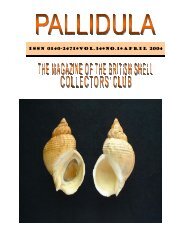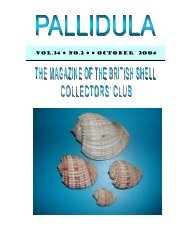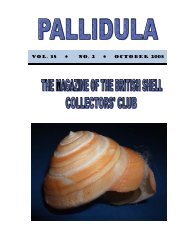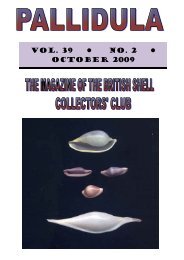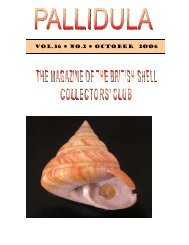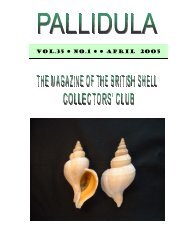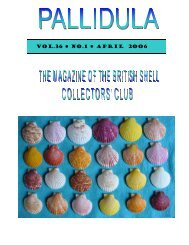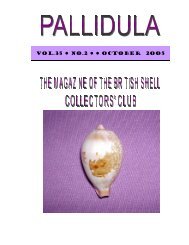VOL.37 NO.1 APRIL 2007 - British Shell Collectors' Club
VOL.37 NO.1 APRIL 2007 - British Shell Collectors' Club
VOL.37 NO.1 APRIL 2007 - British Shell Collectors' Club
Create successful ePaper yourself
Turn your PDF publications into a flip-book with our unique Google optimized e-Paper software.
PALLIDULA Page 6<br />
Flexopecten proteus and some fantastic Tellina planata with a huge yellow blotch on white<br />
backgrounds. We walked on for about a mile southwards and here we collected more than 50 pairs<br />
of Donacilla cornea with a wonderful range of colours and patterns. We headed back to the car after<br />
a super day’s collecting, totally delighted.<br />
On our seventh day in Greece we sampled several<br />
beaches on the Sithonia peninsula. I had read in<br />
Greek travel guides that the bottom of this peninsula<br />
was very much exposed to the elements and thought<br />
that there could be some interesting species washed<br />
up here. Our first stop was Porto Karra half way<br />
down the west coast of Sithonia. This proved to be<br />
very poor for shells on the beach, probably because<br />
Set of colour variations of Donacilla cornea<br />
it is located deep in the Kasandras gulf and it is not<br />
so exposed to the open sea. As we drove south from Porto Karra we noticed a beautiful little stream<br />
by the roadside. After dredging the stream no freshwater molluscs could be found at all. We did<br />
however see many turtles and some huge frogs. The landscape on the Sithonia is breathtaking, it is<br />
much more mountainous than Kasandra but unfortunately the Sithonian mountains form part of the<br />
Serbo-Macedonian Massif range and the surface rock is primarily made up of Metamorphic Schists<br />
which is just no good for shell building so no land snails could be found here either. The long<br />
sweeping road took us right through the mountains and it seemed to be very difficult to find a way<br />
down to the beaches, the fact that I tend to drive like I am in a rally probably didn’t help. We<br />
eventually found the beach at Kalamitsi. The beach here consisted of a long sandy bay with rocks at<br />
either end. As we worked our way towards the rocks at the far end of the bay we began to find<br />
hundreds of good shells and Craig in particular did very well. Amongst his finds were Natica<br />
stercusmuscarum, Clanculus corallinus, a beautiful Emarginula species and one near gem specimen<br />
of Cirostrema cochlea, a rare find indeed! I imagine this beach could be very useful for the local<br />
collector, particularly after a storm.<br />
We pressed on in attempt to try as many beaches as possible and arrived at Sarti. In a small bay<br />
here, just before the main beach we collected many nice gastropods on the rocks complete with<br />
hermit crabs including Pisania maculosa, Sphaeronassa mutabilis, Euspira guillemeni and some<br />
Gibbula albida with the most striking patterns we had seen. We moved on to the main sandy bay in<br />
the town but unfortunately there was very little to be found there. Amongst other beaches sampled<br />
on the peninsula were Koufos, Toroni and Kolgria. All of these beaches produced very few shells.<br />
On the start of our second week in Greece we headed for the hills to the East of Thesaloniki to look<br />
for land snails. We passed through a lovely little town called Panorama and soon reached about 6-<br />
700metres altitude. We came across what appeared to be an old Limestone quarry. On a small area<br />
near the car we collected some lovely Zebrina, Helicella and Helix melanostoma. As I searched<br />
thoroughly with my nose to the grindstone I found some tiny snails called Cochlostoma. I collected<br />
about 15 specimens. We then set off to look for freshwater shells. We drove 40km north west to the<br />
Gallikos river at Mandres. The river here was quite wide but very shallow, no more than 2’ deep at<br />
any point with platforms here and there. At the large road bridge we found a lot of flood debris.<br />
Dredging the bottom sediment and the weeds failed to produce a single snail! And even the flood<br />
debris was disappointing. We collected some small shells in the flood debris, mostly Planorbis<br />
(Ram’s horn snails) and a few species of land snails which had been washed in to the river at some<br />
point. We began the long drive back to the resort and stopped at Afytos on the East coast of the<br />
Kassandra peninsula. Craig had read that Afytos was good for urchins and thought it could well be<br />
good for shells also. Unfortunately there was very little there. We did however collect a couple of<br />
interesting land snail species by the path down to the beach. It was hard going though because there<br />
were huge wasps there and they were not very friendly.<br />
The following day we decided to do a thorough search for good beaches on our peninsula, in<br />
preparation for our last 5 days of the holiday when we would be without transport and would have to<br />
rely on the local buses. The beach at Kalyves was our first stop and this was very poor for shells.<br />
We then tried a lovely little place on the headland just south of Fourka called Poseidi. We walked for<br />
about 1km before we found anything. At this point we found some very good shell grit. Within<br />
minutes I had found 4 beautiful specimens of Truncatella subcylindrica. I filled a bag full of shell grit



